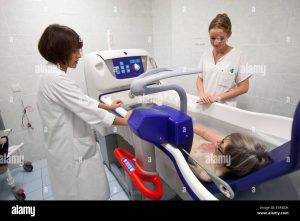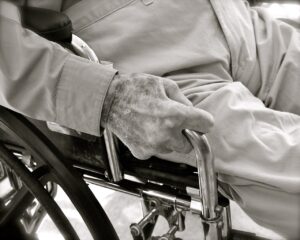Sitz Bath Overview
A sitz bath is a therapeutic method involving sitting in warm or cool water to address various conditions. It can be created using a bathtub, a large basin, or special devices that fit into toilet bowls. The term “sitz bath” is derived from the German word “Sitzbad,” meaning a bath in which one sits.

Objectives:
- Relieve Muscle Spasm:
- Alleviate muscle tension and spasms.
- Soften Exudates:
- Aid in softening and facilitating the removal of exudates.
- Hasten Suppuration Process:
- Promote the process of suppuration (pus formation).
- Hasten Healing:
- Accelerate the healing process of wounds or injuries.
- Reduce Congestion and Provide Comfort:
- Alleviate congestion and offer comfort in the perineal area.
Purposes:
- Aid in Healing Wounds:
- Clean discharges and slough from wounds in the perineal area.
- Induce Voiding in Urinary Retention:
- Assist in prompting urination for individuals experiencing urinary retention.
- Relieve Pain, Congestion, and Inflammation in Cases of:
- Hemorrhoids
- Tenesmus
- Rectal surgery
- Anal fissures
- After proctoscopic or cycloscopic exams
- Sciatica
- Uterine and renal colic
- Induce Menstruation:
- Stimulate the onset of menstruation.
Indications:
- Hemorrhoids
- Anal Fissures/Surgery
- Episiotomy
- Uterine Cramps
Important Considerations:
- Warm water should not be used if significant congestion is already present.
- Monitor the patient closely for signs of weakness and faintness.
- Check for pressure against the patient’s thighs or legs after they are in the tub or chair.
- Provide support to the patient’s back in the lumbar region.
Contraindication:
- Menstruating or pregnant women
Equipment:
- Sitz tub half-filled with water (105°F)
- Pitcher of water (130°F)
- Bath thermometer
- Ice cap with cover
- Fresh camisa
- Bath towel
- Bath blanket
- Rubber ring (as needed)
Preparation:
- Take all necessary equipment to the bathroom or treatment room.
- Run water into the tub and check the temperature (105°F or 40.5°C).
- Place a rubber ring at the bottom of the tub if needed or line the bottom with a towel.
Charting:
- Type of solution
- Length of time of application
- Type of heat application
- Condition and appearance of the wound
- Comfort of the patient
Additional Equipment:
- Available bathroom with an appropriate-sized tub for the patient
- Towels and bathmat
- Bath blanket
- Inflatable ring
- Patient’s clean clothes
Nursing Interventions | Rationale
- Check physician’s order for sitz bath patient.
- Rationale: To determine if a sitz bath is medically indicated for the patient.
- Prepare the materials needed:
- Take linen to the bathroom.
- Fill a clean tub about one-third full with warm water.
- Check water temperature (105°F to 110°F or 40.5°C to 43.3°C).
- Place a towel or inflatable ring on the tub bottom and a bathmat on the floor beside the tub.
- Rationale: To save time and effort, ensuring a smooth and organized procedure.
- Explain the purpose and procedure to the patient.
- Rationale: To inform and educate the patient about the purpose of the sitz bath and the steps involved.
- Test the water in the sitz with a thermometer before the patient enters the tub.
- Rationale: To ensure the water temperature is appropriate for the intended therapeutic purpose. Warm water should not be used if there is considerable congestion. Temperature varies based on therapeutic goals.
- Assist the patient into the tub, ensuring proper positioning.
- Check for pressure against the patient’s thighs or legs.
- Use a stool if the patient’s feet do not touch the floor.
- Place a towel in the water to support the patient’s back if necessary.
- Rationale: Proper positioning enhances comfort and prevents discomfort or pressure points.
- Wrap a bath blanket around the patient’s shoulders, draping the ends over the tub.
- Rationale: To protect the patient from feeling chilly and exposure during the sitz bath.
- Observe the patient closely for signs of weakness and fatigue.
- Use a cold compress at the back of the neck or forehead to prevent weakness.
- Discontinue the bath if the patient’s condition warrants.
- Rationale: To monitor the patient’s well-being and respond promptly to signs of distress.
- Test the water in the tub several times and maintain the desired temperature.
- Additional hot water may be added cautiously.
- Agitate the water to prevent burning the patient.
- Rationale: Ensuring the water remains at the desired temperature for the duration of the sitz bath.
- Do not leave the patient alone unless it is absolutely certain that it is safe to do so.
- Rationale: Ensures the safety of the patient during the sitz bath.
- Help the patient out of the tub when the bath is completed.
- A hot sitz bath is typically continued for 15 to 30 minutes.
- Help the patient dry and cover adequately.
- Rationale: Ensures a safe and comfortable transition out of the sitz bath.
- Assist the patient to their bed and keep them away from drafts until normal circulation returns.
- Rationale: Promotes patient comfort and prevents potential complications during the recovery period after the sitz bath.
Read more: Nurse Bag Essentials
Read more: BSc/RN/PHN/RM Practical Questions

